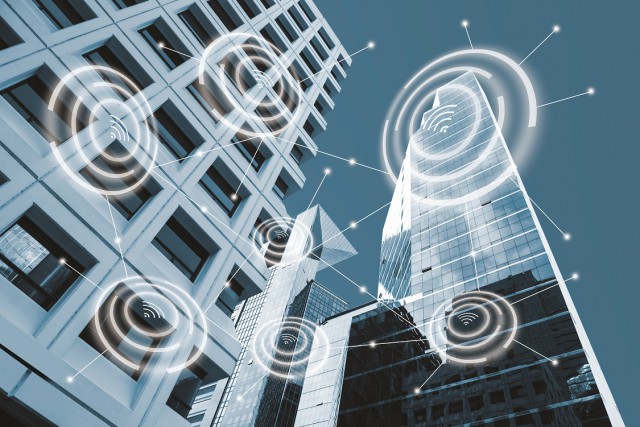The technology behind smart buildings

Connectivity in smart buildings has huge business value. Mike Hook explains.
Smart buildings are increasingly at the centre of discussions about the future of the workplace, as new technology evolves and possibilities increase. However, what is sometimes overlooked is the human side of this issue - the role that smart buildings play in creating positive and personalised experiences for the people working inside them. In truly interactive, flexible smart buildings, these experiences have the potential to completely change our conception of the built environment and the places where we work.
Flexibility and personalisation
For example, we are seeing the emergence of building features such as wayfinding, space scheduling systems and mobile credential-based access control. All of these systems enable buildings to offer high levels of user-flexibility and agility as well as the personalisation needed to make shared spaces feel owned during their use.
These more connected buildings can also make use of location-based services and a complex array of behavioural and movement data to understand how space is used on a real-time basis. Not only does this allow occupiers to identify under-utilised space, but it also prompts more informed user-led office design that reflects how work is actually done and ensures employees are productive, comfortable and supported.
The technology behind the experience
However, these experiences do not happen on their own, and we cannot talk about these services and features if we don’t also talk about the enabling technologies that underpin them. Perhaps the most crucial of these is connectivity. While we take wired connections, and even Wi-Fi, for granted in buildings today – we cannot lose sight of the vital role it plays as the workspaces we build continue to evolve.
In fact, universal connectivity continues to be a vital pre-requisite for enabling every aspect of the smart buildings vision. This doesn’t just encompass the connectivity we already come to expect, but also includes factors like bringing mobile 4G and soon 5G connectivity into buildings.
Creating this reliable, robust backbone of connectivity – of every type – is critical if we are to be successful in using technology to establish compelling new standards for the built environment and engender new working cultures within organisations. For example, a 5G network will play a crucial role in realising the full benefits of IOT devices and systems.
The connectivity challenge
However, creating this level of permanent connectivity is no easy task. Even traditional ICT infrastructure fitout – involving wired and Wi-Fi connectivity – is a huge challenge on its own.
The process of deploying all of the physical infrastructure, the access points and the supporting systems is a massive undertaking – to say nothing of specifying and connecting the potentially tens of thousands of devices that will rely on these networks.
The addition of mobile connectivity steps this challenge up a level, but is a vital hurdle to overcome, as today’s businesses see it as huge priority when planning and fitting out their workspaces.
Without seamless access to 4G service and a plan for 5G future proofing, the connected experiences for employees and visitors are significantly compromised. When companies have invested heavily in enabling these experiences, the last thing they need are connectivity issues derailing the entire process.
The sustainability issue
Another area where smart buildings have great potential to deliver considerable benefits, again only if the connectivity framework is in place, is sustainability. The opportunity to save considerable amounts of energy and make the built environment more sustainable is much touted as one of the key benefits of digitising buildings. However, it’s not yet entirely clear that this potential is being realised.
If you only listened to the hype about the benefits of IoT and the huge increases in the variety of sensors and other end point devices being added to the ecosystem, you might assume that everything is ticking along nicely. But the existence of these end point devices is only part of the picture. Unless connected devices have the infrastructure and support needed to function at a high level and over the long-term, customers will not reap the much-promised rewards from their substantial smart building investments.

For example, deploying some piecemeal IoT sensors cannot deliver the unified services and co-ordination that is required to increase the efficiency of buildings. Only once the connectivity framework is established can these features really perform the way they were intended to.
The reality of delivering sustainability
We need to aim at consolidating disparate IP networks to create an integrated building services network that is the backbone of modern digital buildings. It is only the network that can provide the platform to manage the extended ecosystem of devices required to monitor every aspect of a building and to subsequently enable the harvesting of the resulting data to support sophisticated performance and service monitoring tools.
You need to have the full ‘stack’ of technology to enable the meaningful gains in sustainable practices – energy saving, health and well-being – that business owners and facilities managers want.
In addition, it’s not just about getting the fundamental elements in place. Beyond the install, there is also a longer-term operational challenge that building operators have to grapple with.
What happens when an incident occurs, or a device fails? Quite literally, who are you going to call? Building networks cut across a huge range of technologies and systems – and too often, building managers rely on a host of specialist contractors to deal with each system in isolation.
But this siloed approach is ripe for mistakes and/or communication problems resulting in unintended errors. When everything is built on one central platform, to really take advantage to the opportunities on offer, you really need engineers that understand the whole picture and how each individual system fits into and interacts with the whole.
The value of a connected framework
Once the connected infrastructure is established, the benefits to both the business and its employees are significant. To take the example of one of our clients, Société Générale, the new connected framework they now have in place is allowing the company to change its working methods in a profound way.
People using the building are now able to manage and personalise their entire experience via a company app. This app allows employees and visitors to view an interactive map of the building, book meeting rooms, collaboration and hot-desk spaces; as well as keep up-to-date on Société Générale’s latest news, beat queues for dining, order catering and much more.
Additionally, the connectivity infrastructure also supports services such as touch-screen kiosks located on each floor to assist with wayfinding, or even allow users to locate colleagues in order to ensure close collaboration on any specific task.
Although the major focus is on enhancing the in-office experience for employees, the nature of today’s reality means that increasingly, there will always be a portion of the workforce working remotely. Once inside the meeting rooms, AV equipment for videoconferencing and wireless sharing ensures those working away from the office do not miss a beat.
This is just one example of what is possible with the right connectivity infrastructure, intelligently deployed. When you add in the fact that the cost of ‘a desk’ for an enterprise is as much as £15,000 per annum, it means using space more efficiently and effectively has a hard-financial benefit as well – in the Société Générale example described above, that would have been just under half a million pounds a year in operational cost savings.
The benefits of ubiquitous connectivity, and what it enables to the business, really are overwhelming.
Mike Hook is Executive Director of LMG







